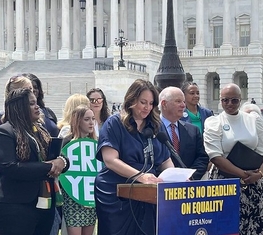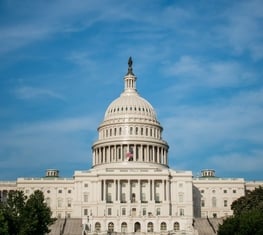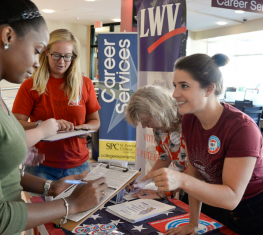Legislative Trends: Preparing for 2023
LWVUS strives to provide guidance and policy outlooks to state and local Leagues around the country.
LWVUS strives to provide guidance and policy outlooks to state and local Leagues around the country. Whether it be legislative tracking, interpretation of bills, or responding to other advocacy inquiries, LWVUS strives to be the best partner to support Leagues at all levels.
We are once again providing an outlook on the trends that Leagues expect to see in state legislatures in the 2023 session. This comes in direct response to feedback from League leaders, and we hope it will be helpful as Leagues consider their legislative priorities for 2023.
TOOLS FROM LWVUS
Legislative Tracking: LWVUS knows that state Leagues do not have the capacity to work on or monitor every issue. LWVUS has the ability set up an online, responsive, legislative tracking board for you to use on the topics and bills you wish to monitor. Email Khadija Ali Amghaiab [email protected]
with any questions about this service and/or to request the creation of a new legislative tracker for your League.
Legislative Office Hours: These office hours will be hosted on the last Thursday of every month, from 3-4pm ET. (Please note the dates as this can vary in months with 5 weeks and are subject to change around holidays.) These meetings will serve as an opportunity for Leagues and League members to address advocacy, legislative, or policy issues directly with a member of the LWVUS staff.
Impact on Issues: Impact on Issues is a PDF guide designed to help League members use LWVUS public policy positions effectively at the national, state, local, and regional levels. The intention is to inspire Leagues to use national positions to act in their own communities.
Federal Action Request Form: While this Legislative Trends document focuses on state and local trends, there is often overlap in the work that Leagues do at the Federal level. If your League is interested in working on federal priorities by communicating with an elected or appointed official, joining a coalition, taking part in a press conference or rally, writing a letter to the editor, or signing with a legal partner using the LWV brand, you first need to complete the Federal Action Request Form for approval of these activities by the LWVUS Advocacy team. This ensures that the League is speaking with one voice and that LWVUS is able to track and support all League action at the Federal level.
Policy Analysis: Would it be helpful for LWVUS policy experts to break down the language in your state legislation? Need more information about how to apply LWVUS positions to state legislation? We want to help! See contact section below.
How to Contact LWVUS Advocacy Team
The LWVUS Advocacy team is run by
Jessica Jones Capparell
Director, Government Affairs
[email protected]
Jessica can help with all inquiries, but for specific inquiries please consider reaching out to individual members of our team listed below
State Level Voting Rights, Redistricting, and Democracy Contacts:
Khadija Ali Amghaiab
LWVUS Policy and Legislative Coordinator
[email protected]
Emerging Issues Contact:
Rebecca Goldman
Justice Reform Legislative and Policy Specialist
[email protected]
Federal Issues Contact:
Kristen Kern
Federal Policy and Advocacy Manager
[email protected]
General Inquiries: [email protected]
ISSUE ANALYSIS: ANTICIPATING LEGISLATION IN 2023
Voting Rights
In the past year, the country saw substantial movement around voting rights issues via both pro and anti-voter provisions/bills. LWVUS utilized the Voting Rights Lab’s comprehensive tracker to inform the trends we saw in 2022 and to help paint a picture of what to expect in 2023.
According to the Voting Rights Lab, 2,187 democracy/voting-related bills were introduced across the country, in 45 states and DC. LWVUS was pleased to see that the majority of legislation, 1,042 bills, seek to explicitly improve voter access; just over a quarter of the pieces of legislation, 580, are classified as “restrictive” of voting rights; and 565 were deemed as neutral or mixed; meaning they could have both good and bad provisions. Only a fraction of these bills became law with 142 being enacted; 43% (or 62 bills) are pro-voter, 21% (or 30 bills) were anti-voter, and 35% (or 5 bills) are mixed/neutral. There are some common themes within these bills that we feel it is important to highlight as something we expect to continue to move.
- Anti- Voter Trends: Unfortunately, we have witnessed the passage of various anti-voter laws that place barriers that make voting more difficult and less accessible. This continues the trend we saw in 2021 as a reaction to the 2020 election. Many of these provisions mirror and/or expand upon the anti-voter bills the League fought against in 2021. We do not expect these efforts to end — in fact they may escalate in 2023, especially in reaction to the 2022 midterms. Leagues should continue to mobilize around and fight against any legislation that would make voting more difficult.
Below are a few common themes amongst these anti-voter laws, but they are not the only types of provisions many states are seeing.
- Limits/Prohibitions to Private Election Funding: In 2022, 10 states (AZ, ID, KY, MS, PA, SC, SD, VA, WV, WI) passed legislation that, in some form, prohibits elections, election officials, election administrators, and/or voter registration efforts from receiving funds/grants from nongovernmental, private sources. Depending on how these laws are written, these types of bills could impact how the League works to support elections and conduct voter registration activities.
- Targets on Ballot Drop Boxes: Another barrier that is being put in place is the limiting or outright banning of ballot drop boxes. This makes it more difficult for voters to return their ballots and can exacerbate accessibility issues. In 2022, we have seen this in three states (FL, MO, SC), on top of the states which passed similar provisions in 2021 (GA, TX, IA ,FL)
- Voter Identification Requirements: Another anti-voter provision we are continuing to see is restrictive voter ID requirements. In 2022, four states (MO, OK, SC, UT) have enacted provisions that require an ID in order to vote. The majority of these bills attach new requirements when voting with absentee ballots.
- Pro-Voter Trends: Thankfully we are also seeing a wide range of laws being enacted across the country that would expand opportunities, accessibility, and support for voters. Numerous state legislatures are stepping up to protect voters and reform laws to make voting more accessible and safer, which is critical as Congress stalls on passing voting protections at the federal level. The League will always speak up and advocate for expanding voting rights provisions. Below are just a few of the provisions we are seeing that expand voting access and reform voting.
- Expansion of Voter Registration: Numerous states have enacted legislation that make voter registration easier and more accessible and provide for more diverse options. The legislation does so in a variety of ways, such as expanding online and automatic voter registration as well as options to register for high school students. Growing voter registration options is a high priority for the League and we are excited to see these reforms continue in 2023.
- Expansion of Voting Opportunities: States are enacting laws that continue the trend of implementing or lengthening early voting, increasing access to absentee ballots, expanding ballot drop boxes, and expanding vote-by-mail or vote at home provisions. The League will continue to support efforts to expand opportunities to vote.
National Popular Vote
Since 2018, the League has supported the National Popular Vote Interstate Compact (NPVIC), and moving into 2023 we expect that this will become a priority in many states. The compact has already been enacted in 15 states and DC, which amounts to 195 electoral votes. This leaves them just 75 electoral votes to reach the 270 needed to implement a National Popular Vote. Additionally, the NPVIC has already passed in one chamber of 9 state Legislatures (AZ, AK, ME, MI, MN, NV, NC, OK, VA) who control 88 electoral votes.
State Leagues with opportunities to expand the NPVIC should plan to engage more around this work. LWVUS will support and lean on our state and local Leagues in this work.
Redistricting
The 2021 redistricting cycle demonstrated an unprecedented level of community engagement and grassroots advocacy, which Leagues led on the state and local levels nationwide. Leagues knew that each point in the process was vital: keeping communities of interest intact when drawing district lines and including their voices through testimony, ensuring that public interest was seriously considered, and demanding transparency in the map-drawing process.
This past cycle was also an opportunity to proactively build many redistricting reforms, such as recently instated redistricting commissions as well as state-level districting rule reforms, including an emphasis on the preservation of communities of interest (COIs) when drawing district lines and rules targeting prison gerrymandering. These opportunities were the results of grassroots advocacy in the years leading up to the 2021 cycle.
These reforms resulted in varying levels of success:
-
- Independent Redistricting Commissions: 17 states had some kind of commission in place in their congressional redistricting process. Three (CT, IN, OH) had backup commissions; four (ME, NM, NY, UT) had advisory commissions; 10 states had independent redistricting commissions whose primary authority was to draw congressional maps (AZ, CA, CO, HI, ID, MI, MT, NJ, VA, WA).
- Reforms which adhere to the following redistricting standards: Leagues advocated for maps whose standards:
- Are enforceable in court
- Require substantially equal population, geographic contiguity, and effective representation of racial and linguistic minorities
- Provide for partisan fairness, preservation and protection of communities of interest, and respect for boundaries of municipalities and counties
- Consider compactness and competitiveness insofar as they do not conflict with above criteria
- Reject the protection of incumbents as well as preferential treatment for a political party
- Prison Gerrymandering: 11 states so far have passed reforms to end prison gerrymandering in order to count incarcerated individuals in their home districts. This past cycle, 8 states’ (CA, CO, CT, DE, NV, NJ, VA, WA) laws reforming prison gerrymandering came in effect for the 2021 redistricting cycle.
While the 2021 redistricting cycle has ended, advocacy work around redistricting reform has not. Many Leagues spent the months following the end of the 2021 redistricting cycle educating their state and local communities about their newly enacted local, state, and congressional maps. And Leagues should look ahead to the coming years for a relaunch of the People Powered Fair Maps ™ (PPFM) for the 2031 redistricting cycle, and as things to consider starting as early as 2023.
Emerging Issues
Equal Rights Amendment (ERA): At the 2022 Convention, the League reaffirmed its ongoing commitment to the Equal Rights Amendment by adding it to the LWVUS program. In 2022, state-level ERAs went before the legislature in two states (ME and NY) and will appear on the November 8th ballot as a legislatively referred amendment in Nevada.
State and local Leagues are encouraged to take action at their respective levels of government to support ERA ratification and efforts to bring laws into compliance with the ERA through:
- Work on state-level ERAs;
- ERA-related legislation; and,
- Audits of local or state statutes and administrative codes for ERA compliance.[RG1] (Please reach out to Rebecca Goldman for more information if your League is interested in this)
Reproductive Choices: In anticipation and the wake of the US Supreme Court’s ruling in Dobbs v. Jackson Women’s Health Organization, which overturned Roe v. Wade and the constitutional right to abortion, state legislatures have been passing both protections and restrictions on the right to an abortion. State legislatures have rapidly worked to revitalize, introduce, and implement new and existing abortion bans and “trigger” bans, as well as abortion rights and access bills, ballot measures, and constitutional amendments.
See the LWVUS Reproductive Rights state advocacy strategy as a resource for state Leagues’ advocacy.
- Abortion bans and restrictions: 26 states, all of which have multiple abortion bans on the books, have been predicted to ban abortion in the wake of Dobbs, stripping more than 36 million women and people who may become pregnant, of the right to reproductive choice. These states were identified based on multiple factors, including enjoined pre- or post-Roe bans, which could be implementable by a court ruling, and “trigger” bans, which are existing laws that take effect automatically or by swift state action in the absence of Roe. In the first half of 2022, 12 states enacted 43 abortion restrictions.
- Bans: As of August 17, abortion is banned at conception with very limited exceptions in at least nine states (AL, AR, KY, LA, MS, MO, OK, SD, TX). Many states are enforcing other pre-viability bans, bans on abortion at a particular point in gestation before a fetus is likely to survive outside the womb. Bans at six weeks from the last menstrual period are often referred to as “fetal heartbeat bills” and are currently in effect in multiple states.
- Medication abortion: As medication abortions account for a growing percentage of US abortions and complicate the enforcement of state abortion bans, some states have proposed bills that explicitly ban the use of medication abortion and multiple have passed restrictions, such as requiring prescribers to be licensed physicians or requiring a patient to have an in-person visit.
- Interstate travel: Based on model legislation written by anti-choice organizations, upcoming bills may attempt to ban interstate travel for abortion services. This sort of measure failed in Missouri in 2022.
- Contraception: With the passage of laws that outlaw abortion from conception, legislatures could introduce bills to restrict access to certain contraceptives such as intrauterine devices and emergency contraception.
- Fetal personhood language: Legislatures may continue to introduce bills that would work fetal personhood language into state statute by referring to a fetus as an “unborn child” or “baby.”
- Ballot measures/constitutional amendments: In 2022, voters in three states (KS, KY, MO) have or will vote on a state constitutional amendment specifying that the constitution does not protect abortion or require funding for abortion care, or a state statute that would classify fetuses born at any stage of development as “legal persons.”
- Abortion protections: There are 16 states and the District of Columbia with legislation that protects the right to an abortion. Some of these states have passed additional legislative protections, such as laws that explicitly protect the right to abortion, expand the pool of clinicians qualified to provide abortion services, require insurance providers to cover abortion, establish state funds to cover abortion costs, or protect people who provide, support, or seek abortion services from out-of-state penalties. In 2022, voters in three states (CA, MI, VT) will vote on an amendment that would enshrine the right to reproductive freedom in the state constitution.
Gun Safety: In 2022, at least 10 states (CA, CO, DE, IL, MD, NJ, NY, RI, VT, WA) passed gun safety laws, many in the form of gun safety packages. Common protective measures included:
- Further regulating or prohibiting ghost guns and high-capacity magazines;
- Raising the minimum age to purchase firearms and/or ammunition from 18 to 21;
- Enhancing background checks; and,
- Prohibiting open carry in specific locations, such as in Colorado near ballot drop boxes or buildings with polling locations or vote counting facilities.
Currently, eight states (AZ, CA, FL, GA, LA, NY, TX, VA) and the District of Columbia have laws explicitly prohibiting firearms at polling places and four states (MO, MS, NE, SC) prohibit concealed carry at the polls.
In June, the US Supreme Court decided New York State Rifle & Pistol Association Inc. v. Bruen, where it struck down New York's licensing scheme for concealed carry licenses for firearms that required that a person provide a justification for seeking a concealed carry permit. Of note, all nine Justices critically affirmed polling places as “sensitive places” in need of protection, leaving the door open for states to keep guns out of polling places.
The same month, the federal Bipartisan Safer Communities Act was signed into law, which allocates $750 million for states to implement crisis intervention services including extreme risk protection order laws. Due to these changes, some legislatures are likely to introduce bills to make it easier to own and carry firearms, and others are likely to introduce additional gun safety legislation, whether at election locations or more broadly.
Climate/Environment: Climate change is a serious threat facing our nation and planet and requires an interrelated approach, especially to address the disproportionate impact that its negative effects have on the most vulnerable populations. States have the power to design their own climate action plans using coordinated legislative vehicles or state administrative actions. Leagues are encouraged to work with leaders and decision-makers in their states to find the best state-based options for action.
- Resilience: Increasingly, states that are greatly impacted by the negative effects of climate change are introducing legislation to address resilience building in preparation for events like flooding, drought, storms, wildfires, and agricultural impact.
- Greenhouse gas (GHG) emissions: To date, 25 states have set GHG emissions reduction targets. Many states are pricing carbon, including the Pacific coast states that have or will soon have a price on carbon, and 12 mid-Atlantic and northeastern states (CT, DE, MA, MD, ME, NH, NJ, NY, PA, RI, VA, VT) that are members of the Regional Greenhouse Gas Initiative, which uses a cap-and-trade system to reduce power plant emissions. 32 states have Renewable Portfolio Standards, or targets set to replace fossil fuels with non-carbon sources by specified dates. 12 states are regulating or otherwise controlling hydrofluorocarbons (HFCs) and methane, two of the most potent GHGs.
Additionally, there have been growing legislative efforts to incentivize more electric vehicles and charging infrastructure, as well as to address agriculture and food waste as net GHG emitters. - Environmental justice: States have increasingly introduced legislation to address the inequitable impact of climate change and related solutions on marginalized communities. Such efforts have targeted sections of the economy that may change (e.g. coal mining) and communities that are often hit the hardest by climate consequences.
Partners in Advocacy
LWVUS provides this analysis as a service to state Leagues. This document should be considered guidance for Leagues as they consider setting their legislative priorities. We hope that Leagues will find these Legislative Trends informative to their work and help guide their strategy, advocacy, lobbying, and activity during the coming 2023 State Legislative Session.
These trends are from issues within LWVUS's Making Democracy Work Campaign, as well as emerging issues that LWVUS is prioritizing. These are not the only issues or trends that we are seeing, but are ones LWVUS wanted to uplift as key during the last legislative sessions, which we want state and local leagues to be on the lookout for in 2023. Leagues are encouraged to reach out to the Advocacy and Litigation department at LWVUS for additional assistance or policy guidance.
Related Materials
Related Content
LWVUS strives to provide guidance/policy outlooks to our Leagues around the country. We are revamping our legislative guidance to provide an outlook on trends that are expected in state legislatures.
To guide its work in Congress, the LWVUS Board adopts lobbying priorities every year. The goal is to maintain focus on issues of primary importance identified by LWVUS.




